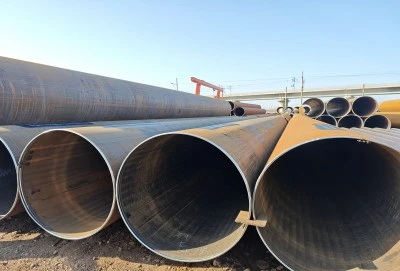The key difference between solid and hollow tubes lies in their internal structure and material distribution. Hollow steel tubes are engineering marvels that feature a void-centered design, while solid tubes are filled throughout. This fundamental distinction affects their strength-to-weight ratio, performance, and applications across various industries.
|
|
|
Structure: Solid vs. Void-centered Designs
Hollow steel tubes:
Hollow steel tubes represent a pinnacle of engineering innovation, offering remarkable strength despite their void-centered design. These tubular structures distribute material efficiently along their circumference, creating a robust framework that can withstand significant stresses. The hollow core allows for optimal material usage, reducing weight without compromising structural integrity.
In the realm of industrial manufacturing and large-scale engineering projects, hollow steel tubes have become indispensable. Their unique geometry allows for enhanced load-bearing capacity, making them suitable for applications ranging from offshore oil platforms to water supply systems. The void within the tube also provides space for additional reinforcement or the passage of fluids, further expanding their utility in pipeline construction.
Material distribution in solid and hollow sections
The distribution of material in solid and hollow sections plays a crucial role in their performance characteristics. Solid tubes concentrate mass throughout their cross-section, resulting in a uniform distribution of stress. This configuration can be advantageous in scenarios requiring high compressive strength or resistance to torsional forces.
Conversely, hollow steel tubes strategically allocate material to the outer edges of the cross-section. This distribution maximizes the moment of inertia, enhancing the tube's ability to resist bending and buckling. For structural engineers working on bridge construction or building frameworks, this property is particularly valuable, allowing for the creation of lighter yet stronger structures.
Structural integrity: Comparing solid and hollow designs
When assessing structural integrity, both solid and hollow designs offer unique advantages. Solid tubes excel in applications requiring high compression resistance and are less susceptible to local buckling. They can be particularly useful in short-span supports or where dimensional stability is paramount.
Hollow steel tubes, however, often surpass their solid counterparts in overall structural performance. Their ability to resist bending moments and provide torsional rigidity makes them ideal for long-span structures and complex architectural designs. In the context of offshore platform construction, hollow tubes offer superior resistance to wave and wind loads while minimizing the overall weight of the structure.
Weight Distribution: Impact on Performance
Lightweight hollow tubes revolutionize constructionThe advent of lightweight hollow tubes has revolutionized the construction industry, particularly in large-scale engineering projects. By reducing the overall mass of structural elements, hollow steel tubes allow for taller buildings, longer bridges, and more efficient use of materials. This weight reduction translates to lower transportation costs and easier on-site handling, streamlining the construction process.
In the context of oil and gas transportation infrastructure, the lightweight nature of hollow tubes facilitates the creation of extensive pipeline networks. Project procurement managers find that these tubes offer an optimal balance between strength and weight, allowing for more cost-effective and efficient transportation of resources across vast distances.
Load-bearing capacity: Solid vs. hollow steel sections
When comparing the load-bearing capacity of solid and hollow steel sections, it's essential to consider the specific application and loading conditions. Solid sections generally offer higher compressive strength per unit area, making them suitable for short columns or applications where axial loads dominate.
Hollow steel tubes, however, often demonstrate superior performance in scenarios involving bending moments and lateral loads. Their efficient material distribution allows them to resist buckling more effectively, making them ideal for long columns and beams. This property is particularly valuable in the construction of offshore platforms, where structures must withstand complex combinations of vertical and horizontal forces.
Energy efficiency in transportation with hollow tubes
The use of hollow tubes in transportation infrastructure contributes significantly to energy efficiency. The reduced weight of hollow steel structures in bridges and elevated roadways translates to lower fuel consumption for vehicles traversing these structures. Additionally, in the realm of pipeline engineering, hollow tubes allow for the efficient transport of fluids with minimal energy loss due to friction.
For plant equipment managers overseeing industrial manufacturing processes, the energy efficiency of hollow tube-based systems can lead to substantial cost savings over time. The reduced mass of equipment and support structures translates to lower energy requirements for operation and maintenance, contributing to more sustainable industrial practices.
Choosing Between Solid and Hollow: Application Guide
Industry-specific uses for hollow steel tubesHollow steel tubes find widespread application across various industries, each leveraging their unique properties to meet specific challenges. In the oil and gas sector, these tubes are essential for creating robust and corrosion-resistant pipelines capable of withstanding high pressures and harsh environmental conditions. Their ability to resist external crushing forces makes them ideal for subsea applications.
In the realm of water supply systems, hollow steel tubes offer an excellent balance of strength and flow capacity. Their smooth internal surfaces reduce friction losses, allowing for efficient water distribution over long distances. Structural engineers working on large-scale projects in the Middle East and Southeast Asia often prefer hollow tubes for their ability to span long distances with minimal support, crucial for creating expansive water networks in challenging terrains.
Cost-effectiveness: Hollow vs. solid steel structures
When evaluating the cost-effectiveness of hollow versus solid steel structures, it's crucial to consider the entire lifecycle of the project. While solid steel may have a lower initial material cost per unit volume, hollow steel tubes often prove more economical in the long run. Their lighter weight reduces transportation and installation costs, and their superior strength-to-weight ratio often means less material is needed overall.
For project procurement managers working on large-scale engineering projects, such as those in Australia or the Middle East, the choice of hollow steel tubes can lead to significant cost savings. The reduced material requirements not only lower initial expenses but also contribute to decreased maintenance costs over time, as these structures are often more resistant to fatigue and environmental stresses.
Maintenance considerations for hollow steel sections
Maintenance of hollow steel sections requires specific considerations that differ from those of solid structures. The internal void of hollow tubes can be both an advantage and a challenge. On one hand, it allows for the implementation of corrosion protection systems within the tube, extending the structure's lifespan. On the other hand, it necessitates careful sealing to prevent moisture ingress, which could lead to internal corrosion.
For plant equipment managers and structural engineers responsible for long-term asset integrity, understanding these maintenance requirements is crucial. Regular inspections using advanced non-destructive testing methods, such as ultrasonic testing or industrial radiography, are essential to ensure the ongoing structural integrity of hollow steel tube installations, particularly in corrosive environments like offshore platforms or industrial manufacturing facilities.
The choice between solid and hollow tubes depends on specific project requirements, environmental conditions, and long-term performance needs. Hollow steel tubes offer significant advantages in terms of strength-to-weight ratio, versatility, and cost-effectiveness, making them a preferred choice for many large-scale engineering projects. Their applications span across oil and gas transportation, water supply systems, bridge construction, and offshore platforms.
China Hollow Steel Tube Factory
Hebei Longma Group stands as a leading manufacturer of hollow steel tubes, offering top-quality products for global markets. With advanced production equipment imported from Germany and independently developed technologies, we ensure superior product quality. Our team of over 300 employees, including 60+ technical experts, drives innovation and maintains high standards. Comprehensive testing facilities, including ultrasonic flaw detectors and X-ray systems, guarantee product integrity. We pride ourselves on fast delivery, with standard thickness tubes produced in as little as 7 days. Our certifications, including API 5L and ISO 9001, reflect our commitment to quality. Thanks to our efficient production model and strong supplier relationships, we offer competitive pricing without compromising on quality. For hollow tubes meeting international standards, contact us at info@longma-group.com. We offer various grades (S235, S275, S355), outer diameters (3"-80"), and thicknesses (SCH10-SCH160), with stock quantities ranging from 50-150 tons for quick delivery.














